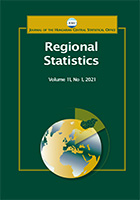Global embeddedness and local responses: Trends in income inequality in Hungary following the 2008 economic crisis
Global embeddedness and local responses: Trends in income inequality in Hungary following the 2008 economic crisis
Author(s): Zoltán Egri, Tamás TánczosSubject(s): Social Sciences, Economy, Geography, Regional studies
Published by: Központi Statisztikai Hivatal
Keywords: global embeddedness; local income inequalities; spatial econometrics; Markov chain
Summary/Abstract: The transition in Central and Eastern Europe after the regime change caused globalisation to intensify. Hungary is regarded as a model of dependent market economies, and can be considered extremely exposed, with its economic development based on exogenous factors. The processes of economic globalisation (foreign direct investment penetration, trade liberalisation, privatisation, and deregulation) have significantly affected, and continue to influence Hungary's territorial inequality systems and spatial structure. The study focuses on a specific period, and its primary objective is to analyse the effects of the global crisis, which began in the United States in 2008, on territorial income inequality in Hungary. The authors seek to answer the question of how globalisation embeddedness shapes income trends relative to national growth, and inequality trends, as well as which factors influence the distribution of income. The analyses will first operationalise global embeddedness and then describe spatial inequality processes along this line, using mathematical-statistical and spatial econometric methods (principal component analysis, exploratory spatial data analysis, Theil index, etc.).In this analyses, the authors first present a multidimensional local (district) pattern of global embeddedness, which shows strong spatial fragmentation in Hungary’s socio-economic and income structure. The global microenvironment suggests significant divergence between settlement groups in terms of income growth, growth factors, inequality trajectories, and income mobility. The results point to the specificities of the factors influencing income inequality, in particular, the higher level of road infrastructure, indicative of the country's endogenous spatial structure, the spatial specificities of labour utilisation, and the main context of the economic structure. In the autors view, the results provide evidence that the settlement level can capture, albeit in a limited way, the key income inequality relations of global embeddedness.
Journal: Regional Statistics
- Issue Year: 13/2023
- Issue No: 04
- Page Range: 714-751
- Page Count: 38
- Language: English

